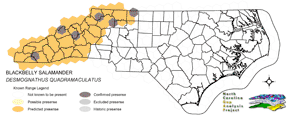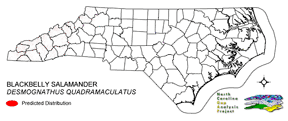
| Taxa: |
| Order: |
| Family: |
| Amphibia |
| Caudata |
| Plethodontidae |
| NatureServe Global Rank: |
| NatureServe State (NC) Rank: |
| G5 |
| S5 |
| Federal Status: |
| NC State Status: |
| --- |
| --- |


| Land Unit |
| US Fish & Wildlife Service |
| US Forest Service |
| US National Park Service |
| US Department of Defense |
| NC State Parks |
| NC University System |
| NC Wildlife Res. Com. |
| NC Forest Service |
| NC Div. of Coastal Mgmt. |
| Local Governments |
| Non-Governmental Org. |
| Other Public Lands |
| Private Lands |
| GAP Status 1-2 |
| All Protected Lands |
| Statewide |
| Hectares |
| 0.00 |
| 12,337.74 |
| 1.62 |
| 4,123.62 |
| 318.42 |
| 2.52 |
| 391.77 |
| 68.49 |
| 0.00 |
| 192.87 |
| 200.34 |
| 0.18 |
| 26,430.39 |
| 5,905.62 |
| 17,622.90 |
| 44,067.96 |
| Acres |
| 0.00 |
| 30,487.21 |
| 4.00 |
| 10,189.68 |
| 786.83 |
| 6.23 |
| 968.08 |
| 241.74 |
| 0.00 |
| 476.59 |
| 495.05 |
| 0.44 |
| 65,310.90 |
| 14,665.60 |
| 43,619.63 |
| 108,966.78 |
| % of Dist. on |
| Prot. Lands |
| 0.0 % |
| 70.0 % |
| 0.0 % |
| 23.4 % |
| 1.8 % |
| < 0.1 % |
| 2.2 % |
| 0.4 % |
| 0.0 % |
| 1.1 % |
| 1.1 % |
| 0.0 % |
| 0.0 % |
| 33.5 % |
| ----- |
| ----- |
| % of Dist. on |
| All Lands |
| 0.0 % |
| 28.0 % |
| < 0.1 % |
| 9.4 % |
| 0.7 % |
| < 0.1 % |
| 0.9 % |
| 0.2 % |
| 0.0 % |
| 0.4 % |
| 0.5 % |
| < 0.1 % |
| 60.0 % |
| 13.4 % |
| ----- |
| ----- |
|
In North Carolina, this salamander is found in the mountains and adjacent piedmont (Martof et al. 1980). It is found in small, medium and large mountains streams that are cool and clear (Petranka 1998). NATURE SERVE GLOBAL HABITAT COMMENTS: In or along swift, boulder-strewn mountain streams. Also near waterfalls and places where cold water drips or seeps. Refuges are in rock cevices or in burrows (Camp and Lee 1996). Usually under rocks in daytime. Sometimes basks in sun on wet rocks. Eggs are laid on undersides of rocks or on tree roots in streambed, apparently in headwater tributaries in North Carolina (Bruce 1985). |
| Code | Name | Description | NC Natural Heritage Program Equivalent |
| 238 | Piedmont/Mountain Submerged Aquatic Vegetation | Seasonally to permanently flooded areas with aquatic vegetation. Waterlily, pondweed, hydrilla smartweed are a few of the species that can occur. | Piedmont/Mountain Semipermanent Impoundment (in part) |
| 239 | Piedmont/Mountain Emergent Vegetation | Emergent vegetation of all wetland hydrologies. Sites would commonly support species such as tussock sedge, rushs, and cattail alliances. | Rocky Bar and Shore (in part) |
| 267 | Riverbank Shrublands | Riverside shrubs with temporarily flooded hydrologies. Found in the both the Mountains and Piedmont. Containing dominants such as smooth alder and a Carolina or black willows. | Sand and Mud Bar |
| 230 | Piedmont Mesic Forest | American Beech - Red Oak - White Oak Forests. | Mesic Mixed Hardwood |
| 383 | Piedmont Mixed Successional Forest | Generally loblolly mixed with successional hardwoods. Sweetgum, tulip poplar and red maple are common co-dominants in these successional forests. | No equivalent |
| 228 | Piedmont Dry-Mesic Oak and Hardwood Forests | Primarily oak dominated forests, white oak is often dominant, with co-dominants including . Also represented by sweetgum and tulip poplar dominated forests. | Dry Mesic Oak Hickory Forest, Basic Oak Hickory Forest, Dry Oak Hickory Forest |
| 222 | Piedmont Dry-Mesic Pine Forests | Loblolly dominated forests resulting from succession following clearing. This type occurs on all moisture regimes following disturbance with the exception of the extremely xeric sites. | No equivalent |
| 382 | Dry Mesic Oak Pine Forests | Mixed forests of the coastal plain and piedmont. Includes loblolly pine with white, southern red and/or post oak and loblolly with water oak. On basic sites of the piedmont, eastern red cedar may co-occur with post, black, and blackjack oaks. | Dry Mesic Oak Hickory Forest, Xeric Hard Pan Forest, Chestnut Oak Forest, Dry Mesic Oak Hickory Forest, Dry Oak Hickory Forest |
| 20 | Coniferous Regeneration | Regenerating pine stands. Predominantly loblolly pine, but slash and longleaf stands occur as well. | No equivalent |
| 36 | Successional Deciduous Forests | Regenerating deciduous trees with a shrub stature. Commonly dominated by sweetgum, tulip poplars and maples. | No equivalent |
| 8 | Open water | Open water without aquatic vegetation. | No equivalent |
| 521 | Spruce/Fir Forest | High Elevation Frazer-Fir - Red Spruce, Red Spruce and Red-Spruce-Yellow Birch Forests. Tree densities included here include both woodland to forest density. Highly intermixed with Northern Hardwoods, Grassy Balds, and Shrub Balds. | Red Spruce--Fraser Fir Forest, Fraser Fir Forest |
| 522 | Northern Hardwoods | High Elevation forests including yellow birch, American beech, and yellow buckeye. Includes forests with Hemlock and Yellow Birch. | Northern Hardwoods Forest, Boulderfield Forest |
| 525 | Appalachian Oak Forest | A variety of oak forest types including Black, White, Scarlet Oaks in dry to mesic situations. Includes forests historically co-dominated by American Chestnut. | High Elevation Red Oak Forest, Montane White Oak Forest |
| 526 | Appalachian Cove Forest | Mixed Mesophytic forests of the mountains. Includes tuliptree, basswood, yellow buckeye and surgar maple. This class is mapped to include cove forests dominated or co-dominated by hemlock. | Rich Cove Forest, Acidic Cove Forest |
| 527 | Appalachian Hemlock | Upland hemlock forests of the moutains region. Vary from side slopes to steep slope positions. | Canada Hemlock Forest |
| 528 | Appalachian Xeric Pine Forest | Pine forests and woodlands on xeric sites. A variety of pines, including Virginia, Shortleaf, Eastern White Pine, Table Mountain and Pitch pine. Often small areas of dense pine within a matrix of Xeric Oak-Pine Forests. | Pine Oak Heath |
| 529 | Appalachian Xeric Mixed Forest | Mixed forests with Virginia, Shortleaf, Eastern White Pine, Table Mountain and Pitch pines in combination with xeric oak species. Oaks include, white, Southern Red, black, and rock chestnut. | Pine Oak Heath |
| 530 | Appalachian Xeric Deciduous Forest | Deciduous forests in the mountains dominated by Xeric Oak species. Species include, white, Southern red, black, and rock chestnut. | High Elevation Red Oak Forest, Montane White Oak Forest |
|
Hairston, N. G., Sr., and R. H. Wiley. 1993. No decline in salamander (Amphibia:Caudata) populations:a twenty-year study in the southern Aplachians. Brimleyana 18:59-64.
Camp, C. D., and T. P. Lee. 1996. Intraspecific spacing and interaction within a population of DESMOGNATHUS QUADRAMACULATUS. Copeia 1996:78-84. Valentine, B. D. 1974. Desmognathus quadramaculatus. Cat. Am. Amph. Rep. 153.1-153.4. Petranka, J. W. 1998. Salamanders of the United States and Canada. Washington DC: Smithsonian Inst. Press. Camp, C. D., and D. G. Lovell. 1989. Fishing for "spring lizards":a technique for collecting blackbelly salamanders. Herpetol. Rev. 20:47. Huheey, J. E., and A. Stupka. 1967. Amphibians and reptiles of Great Smoky Mountains National Park. Univ. Tennessee Press, Knoxville. ix + 98 pp. Conant, R. 1975. A Field Guide to Reptiles and Amphibians of Eastern and Central North America. Second Edition. Houghton Mifflin Company, Boston, Massachusetts. xvii + 429 pp. Behler, J. L., and F. W. King. 1979. The Audubon Society field guide to North American reptiles and amphibians. Alfred A. Knopf, New York. 719 pp. Bruce, R. C. 1985. Larval periods, population structure and the effects of stream drift in larvae of the salamanders DESMOGNATHUS QUADRAMACULATUS and LEUROGNATHUS MARMORATUS in a southern Appalachian stream. Copeia 1985:847-854. Martof, B. S., W. M. Palmer, J. R. Bailey, and J. R. Harrison, III. 1980. Amphibians and reptiles of the Carolinas and Virginia. University of North Carolina Press, Chapel Hill, North Carolina. 264 pp. Bruce, R. C. 1988. Life history variation in the salamander DESMOGNATHUS QUADRAMACULATUS. Herpetologica 44:218-227. Austin, R. M., Jr., and C. D. Camp. 1992. Larval development of black-bellied salamanders, DESMOGNATHUS QUADRAMACULATUS, in northeastern Georgia. Herpetologica 48:313-317. |
For more information please contact them at:
NC-GAP Analysis Project
Dept. of Zoology, NCSU
Campus Box 7617
Raleigh, NC 27695-7617
(919) 513-2853
www.basic.ncsu.edu/ncgap